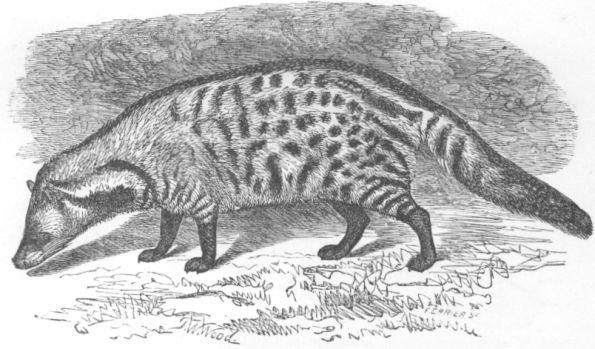- Large Indian Civet
Taxobox
name = Large Indian Civet

status = LR/lc | status_system = IUCN2.3
regnum =Animal ia
phylum = Chordata
classis =Mammal ia
ordo =Carnivora
familia =Viverridae
subfamilia =Viverrinae
genus = "Viverra "
species = "V. zibetha"
binomial = "Viverra zibetha"
binomial_authority = (Linnaeus, 1758)The Large Indian Civet ("Viverra zibetha") is generally a grizzled greyish brown, with white and black bars along their neck (usually two white stripes and three black stripes), stripes on the tail, and a white muzzle. The hair on their back is longer. Their claws are retractable. They have hair in between their paw pads.
=Habitat= The Indian civet ranges fromIndochina toChina . It can be found in the countries of Nepal, Bangladesh, the Malay peninsula, and Vietnam. [ [http://www.iucnredlist.org/search/details.php/41709/dist IUCN Red List of Threatened Species: Viverra zibetha:Distribution] ]Food
The Indian civet is mostly carnivorous. They will eat birds, frogs, snakes, small mammals, eggs, crabs, and fish. They will also eat fruit and roots.
=Social Behavior= The Indian civet issolitary and nocturnal. They spend most of their time on the ground, though they are agile climbers. They spend much of their time during the day sleeping in burrows in the ground that have been dug by other animals and abandoned. They are territorial and mark their territories with excretions form their anal glands. Their territory can range from 0.6-2 mi sq (1.7-5.4 Km sq).
=Reproduction= Females breed at any time of the year, and generally have two litters a year. A litter usually consists of four young. They are born in a hole in the ground or dense vegetation. They open their eyes at 10 days and are weaned at one month old.
=Subspecies=There are five subspecies [http://www.bucknell.edu/msw3/browse.asp?s=y&id=14000270 1] :
*"V. z. zibetha", found in
Nepal ,Bhutan , upperBengal ;
*"V. z. picta", found east ofAssam ,
*"V. z. ashtoni",
*"V. z. hainana", described just in1983 by Wang and Xu,
*"V. z. pruinosus".In
1997 Sokolov, Rozhnov & Pham Trong Anh described new species as "Viverra tainguensis" know fromTainguen Plateau inGialai Province inVietnam . Today research DNA confirm that be comprises the schedule of genes "Viverra zibetha picta" subspecies.Conservation
In
Hong Kong , it is a protected species under Wild Animals Protection Ordinance Cap 170..References
Wikimedia Foundation. 2010.
